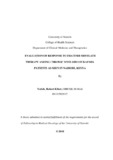| dc.description.abstract | Background: Without treatment, chronic myeloid leukemia (CML) progresses from a
chronic phase (CP) followed by an accelerated phase (AP) and then to the blast phase
(BP).The approval of imatinib mesylate by the Food and Drug Administration (FDA)
in 2001 marked a change in paradigm CML therapy. Therapy with tyrosine kinase
inhibitors (TKI) reduces the CML residual disease to levels which cannot be of
detected by cytogenetic or hematologic testing but only by molecular testing using
quantitative polymerase chain reaction(Qrt-PCR). Guidelines by both National
Comprehensive Cancer Network (NCCN) and European LeukemiaNet (ELN)
establish response milestones for TKI treatment. Early attainment of minimal residual
disease in the treatment with TKIs is predictive of a favourable prognosis. There are
1200 CML patients currently enrolled in the Gleevec International Patient Assistance
Programme (GIPAP) in Kenya. Their molecular response to imatinib therapy is
unknown. This study aimed at determining the molecular response to imatinib among
CML patients enrolled in the GIPAP programme in Nairobi.
Objective: To determine the response to imatinib mesylate among CML patients
attending the GIPAP clinic at the Nairobi Hospital; Kenya.
Methods: This was a cross-sectional descriptive study carried out at the GIPAP clinic
in Nairobi Hospital. Chronic myeloid leukaemia patients who had been on imatinib
for not less than 18 months and gave consent were enrolled consecutively into the
study until a sample size of 207 was attained. The investigator reviewed the patients
and perused through their records to extract socio-demographic, clinical and
laboratory data including breakpoint cluster region-Abelson leukemia virus (BCRABL)
transcript level at baseline and after 18 months of imatinib therapy. Information
was entered in a data entry form, transferred into a data base and analyzed using
STATA version 13 SE.
Results: Out of 215 participants studied, 210 (97.7%) were in chronic phase. Most of
the participants, 138 (64%) had a low EUTOS risk score at entry. The median period
of clinic follow up was 4.7 years. Almost a half, 105 (49 %) of the participants had
been exposed to hydroxyurea. The median duration to initiation of imatinib was 4.9
weeks. Majority of the participants, 180 (84%) achieved complete hematologic
remission (CHR) at 3 months. More than a half of the participants reported having
missed a dose. One third 74 (34%) of the participants had optimal response, 34 (20%)
had treatment failure and 98 (46%) had suboptimal response. High EUTOS score
(24% vs. 42%, p = 0.011), prior treatment with hydroxyurea (35% vs. 56%, p <0.001)
and poor adherence (26% vs. 69%, p <0.001) were associated with suboptimal
response and treatment failure.
Conclusion: This study demonstrated that a minority of the participants, 74 (34%)
had an optimal treatment response and 34 (20%) had treatment failure. A high
EUTOS score, prior treatment with hydroxyurea and poor adherence were associated
with poor response to imatinib therapy.
Recommendation: Measures should be instituted to improve access and adherence to
treatment with imatinib among CML patients attending the GIPAP clinic. | en_US |



